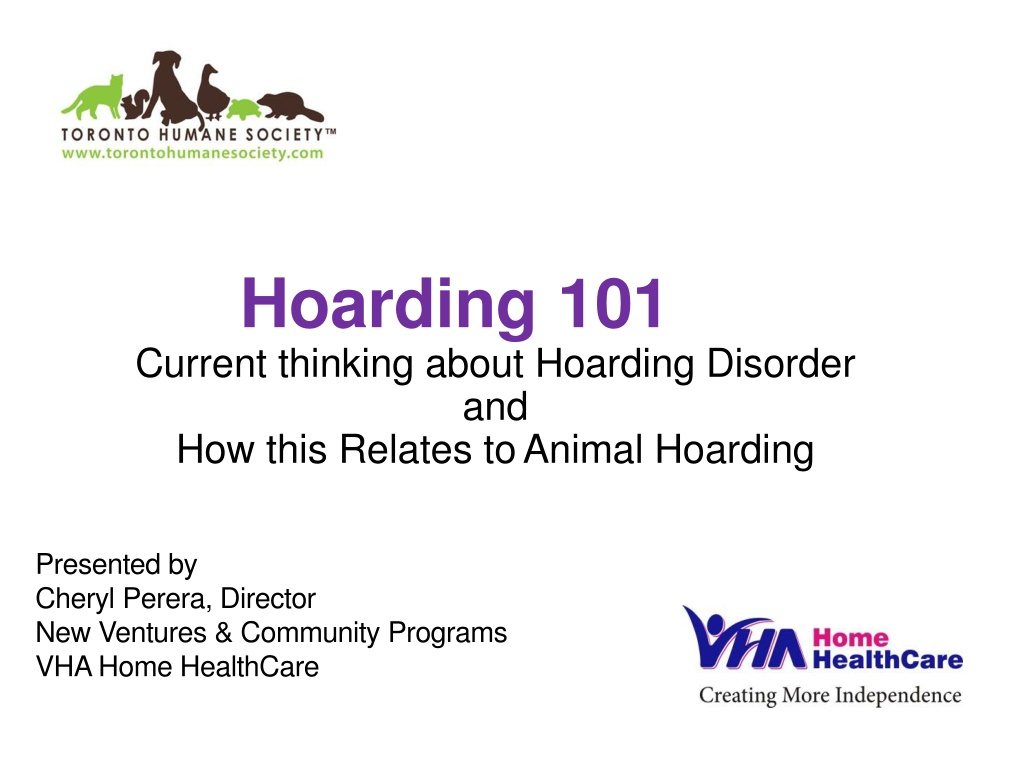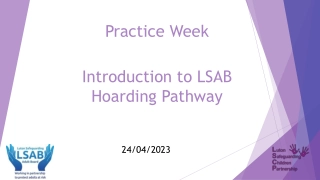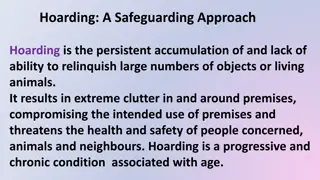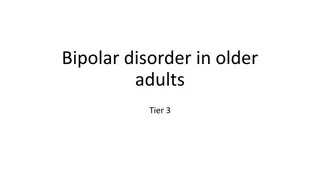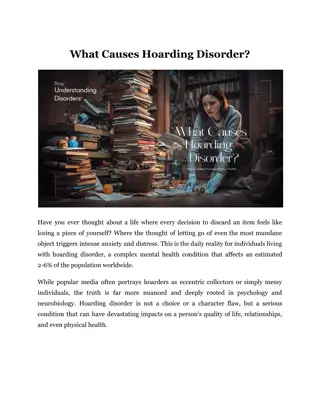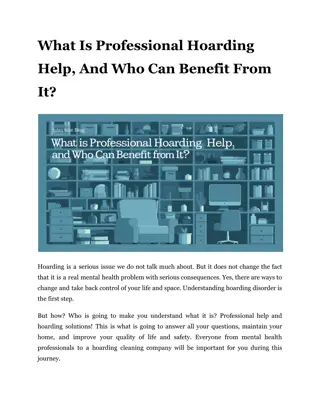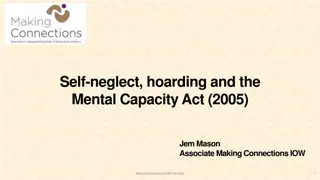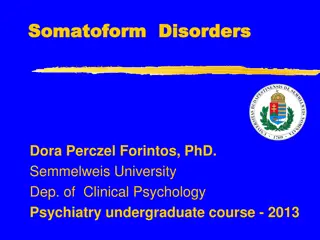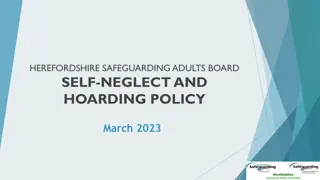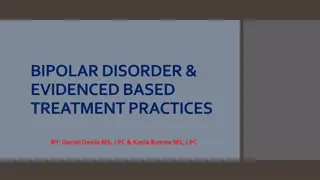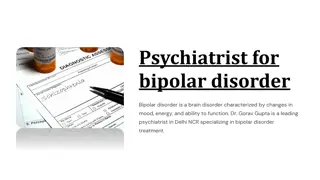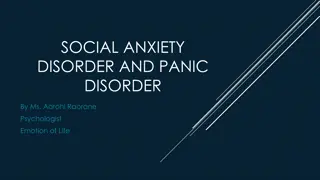Understanding Hoarding Disorder and Its Relation to Animal Hoarding
Explore the complexities of hoarding disorder and how it intertwines with animal hoarding behavior. Delve into the characteristics, practical tips, and service interventions related to hoarding. Learn from Cheryl Perera, Director of New Ventures & Community Programs at VHA Home HealthCare, about the mental distress, clutter spectrum, and inside the mind of hoarders. Discover resources and programs offered by VHA in partnership with organizations like Toronto Humane Society. Gain insight into identifying hoarding behavior and taking necessary steps towards intervention and support.
Download Presentation

Please find below an Image/Link to download the presentation.
The content on the website is provided AS IS for your information and personal use only. It may not be sold, licensed, or shared on other websites without obtaining consent from the author. Download presentation by click this link. If you encounter any issues during the download, it is possible that the publisher has removed the file from their server.
E N D
Presentation Transcript
Hoarding 101 Current thinking about Hoarding Disorder and How this Relates toAnimal Hoarding Presented by Cheryl Perera, Director New Ventures & Community Programs VHA Home HealthCare
Overview What is Hoarding? Characteristics of Hoarding with respect to Animals Practical tips for identifying and understanding hoarding behavior Understanding Service Intervention Resources/Services & Next Steps
VHA Home HealthCare Charity Founded in 1925 Provides home health care (nursing, PS, rehab) Community support services (homelessness prevention, caregiver support, health and wellness) Provincial GTA, London/Middlesex, Chatham/Kent/Sarnia/Lambton, Ottawa
VHA & Hoarding Homelessness Prevention Programs offered include, Extreme Cleaning, Hoarding Intervention Services. We train in the area of Hoarding Developed a Hoarding T oolkit Not experts inAnimal Hoarding - NewArea for VHA Partnering with T oronto Humane Society and Ontario Shelter Medicine Association
Definition of Hoarding Excessive acquiring Inability to let go Inability to use spaces as they were meant to be used Mental distress
Clutter vs Hoarding Most of us have some clutter We see clutter and hoarding on a continuum At the low end of the continuum, clutter does not interfere with our lives
VHA TOOLKIT The Clutter Spectrum Page 14 As with any human behaviour, accumulating possessions can range from adaptive to excessive Petrusa et al. (2010). Refining the Diagnostic Boundaries of Compulsive Hoarding. Clin Psychol Rev, 30: 371-186] 2015 ONPHAConference & Trade Show #ONPHAconf
Inside the Mind of Someone Who Hoards TOOLKIT Page 25-30 Sentimental Instrumental Intrinsic
Practical Signs Someone may be Hoarding Difficult gaining entry (not answering the door, saying it s a bad time) Denial/minimizing/rationalizing Length of time person has lived with excessive clutter Significant distress during conversations related to cleaning out the clutter Other?
Squalor vs Hoarding People assume someone living in poor conditions and has excessive clutter hoards Reasons someone might be living in squalor mental health issues (not related to hoarding disorder), age- related declining physical ability, chronic illness Hoarding behaviour adds another dimension and changes the dynamic of how you will address home condition
Animal Hoarding Object Hoarding vsAnimal Hoarding Animal Hoarding and the DSM-5 Animal Hoarding behaviour adds another dimension and changes the dynamic of how you will address home condition
Classification of Animal Hoarders Dr. Patronek & colleagues have suggested 3 Classifications 1) Overwhelmed Caregivers passive acquisition, caring, some awareness 2) Rescuers mission driven, more active acquisition 3) Exploiters active acquisition, little attachment to animals, serving their own needs, hardest to intervene (may not fit the HD Diagnosis in DSM) Very little research exists to confirm these classifications
Similarities and Differences between Object Hoarding and Animal Hoarding Similarities Chronic nature of the behaviour, poor insight Urge to save/acquire is intense Extreme distress caused by letting go Differences Home environment level of filth Complexity of a addressing the situation, need for partnership across sectors
Low Insight 12% 15% AWARE OF IRRATIONALITY OF BEHAVIOUR LITTLE INSIGHT NO INSIGHT 73% Steketee, Frost & Kim (2001). Hoarding by Elderly People. Health and Social Work 26(3): 176-184 Many who hoard have low insight into their behaviour.
Intervention Chronic Progressive
Intervention Realistic goals
Cleanouts are not a quick fix BEFORE Hoarders after CleaningAssistance or Clearout 50 AFTER 40 30 20 10 0 no improvement clutter worsened sustained improvement some Photos: www.bowdecon.com/JobPhotos.html improvement then relapse Steketee, Frost & Kim (2001). Hoarding by Elderly People. Health and Social Work 26(3): 176-184 Clearing out belongings solve a symptom, not the problem
Successful Interventions Identification Good assessment Respectful and client-centred Reliant on partnerships and communication Measured and not focused on quick fixes Creative but realistic Ongoing support (ranging from informal to group support etc.)
Treatment Basics Consent-based services only clients can refuse service at any time Intervention becomes problematic when animals or others are at risk and client is not consenting We can work with community partners, landlords and enforcement within limits Privacy laws client can restrict our ability to speak to others we may not be able to give you an update if you refer a client to us
Assessment Understand where the client is at Helps in goal-setting May reveal client isn t ready for change may have to focus on harm reduction Determines if client is ready for change treatment group, individual CBT , sorting coach May rely on enforcement services when client has no insight or unwilling
Assessments 1. Health & Safety Checklist 2. Function Checklist 3. Saving Inventory 4. Clutter Beliefs Checklist Page 31 5. Clutter Image Rating [Frost, Steketee, Tolin, Renaud, 2008] VHATOOLKIT Page 34 -36
Harm Reduction: May not be open to changing Stages of Change
Harm Reduction (HR) Focus of HR is to reduce the harmful consequences of high-risk behaviour without requiring the behaviour to fully stop Over focusing on discarding/letting go can make situation worse Engage service providers to help with practical solutions e.g. pathways for object hoarding What could this look like for animal hoarding? Sometimes if successful the client will engage for ongoing work
Harm Reduction (HR) T ompkins and Hartl propose 5 steps: 1. Engage the person who hoards in the HR approach 2. Build the HR team 3. Assess the harm potential 4. Create the HR plan 5. Implement the HR plan
Treatment vs. Enforcement Enforcement sometimes only option when clients non-compliant and home condition puts themselves and others at risk Duty to accommodate give clients some time. Engaging with a service provider or anyone they trust is a first step Clients further along in stages of change model often more open to treatment and steps to address the state of their home.
The Power of the Uniform Some clients are motivated to do something different when someone in a uniform makes a suggestion or referral BUT this population can be ambivalent and often doesn t follow through Visiting a client together can be effective but takes coordination
Inside the mind of our Clients Clients are very mistrustful of the system and anyone trying to intervene Extremely distressful to discuss removing objects/animals, extreme anxiety Fearful of being disrespected, have had bad experiences in the past, Fear of losing control over their belongings/animals and what might happen to objects/animals
Engaging a Client Supportive family members/friends can help gain access to a client Other professionals who have a good relationship can provide an entry point Staff often visit client with no support use skill, compassion, and a non-judgemental approach to engage Client who hoards may feel fear, mistrust, etc. and be hard to engage
Creative Solutions Harm reduction strategies: Aslower approach giving the client control over elements of intervention such as # of staff/volunteers, what will happen to objects or animals. Clear pathways and focus on safety Follow-up using volunteer coaches to work with clients and help them maintain Spay and Neutering
Do Measured approach Reach out for help from partner agencies for counselling, housing etc. Focus on getting in the door without forcing the client our services are consent-based Assist by staying in touch with client to check in on progress. Follow through on consequences of non- compliance Provide other supports as necessary
Lack of Service Coordination & Treatment Options While there are treatment options for individuals with hoarding behaviour the availability of these services is limited. The T oronto Hoarding Support Services Network is working on developing better coordination for services and treatment for individuals who hoard but there are still many service gaps in the system. Also, wait times can be significant. We need to work together with the T oronto Humane Society, Toronto Animal Services and other Partners to develop a coordinated approach for animal hoarding situations in our City.
Refer Clients who are Hoarding T oronto The Hoarding Support Services Network (No capacity for severe animal hoarding at this time) VHAHome HealthCare 211 for information re. local services Sunnybrook Health Sciences Centre (groups and psychiatric assessment)
Thank you VHA Home HealthCare (VHA) a not-for-profit charity has provided care since 1925. With over 2,000 staff and service providers VHA offers home and community services that support Ontarians independence including: homemaking, nursing, personal support and rehabilitation services. VHA is: Accredited with Exemplary Standing by Accreditation Canada An RNAO Best Practice Spotlight Organization designate and; A founding member agency of United Way Toronto. www.vha.ca
